
Futurism was an artistic and social movement that originated in Italy, and to a lesser extent in other countries, in the early 20th century. It emphasized dynamism, speed, technology, youth, violence, and objects such as the car, the airplane, and the industrial city. Its key figures included Italian artists Filippo Tommaso Marinetti, Umberto Boccioni, Carlo Carrà, Fortunato Depero, Gino Severini, Giacomo Balla, and Luigi Russolo. Italian Futurism glorified modernity and, according to its doctrine, "aimed to liberate Italy from the weight of its past." Important Futurist works included Marinetti's 1909 Manifesto of Futurism, Boccioni's 1913 sculpture Unique Forms of Continuity in Space, Balla's 1913–1914 painting Abstract Speed + Sound, and Russolo's The Art of Noises (1913).
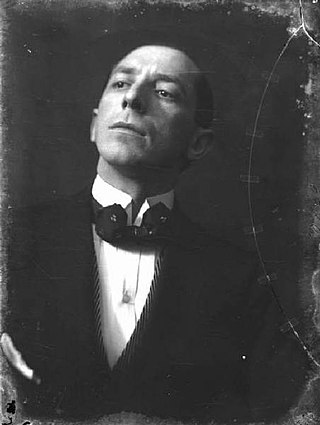
Umberto Boccioni was an influential Italian painter and sculptor. He helped shape the revolutionary aesthetic of the Futurism movement as one of its principal figures. Despite his short life, his approach to the dynamism of form and the deconstruction of solid mass guided artists long after his death. His works are held by many public art museums, and in 1988 the Metropolitan Museum of Art in New York City organized a major retrospective of 100 pieces.

Giacomo Balla was an Italian painter, art teacher and poet best known as a key proponent of Futurism. In his paintings, he depicted light, movement and speed. He was concerned with expressing movement in his works, but unlike other leading futurists he was not interested in machines or violence with his works tending towards the witty and whimsical.
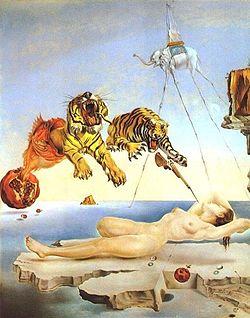
Dream Caused by the Flight of a Bee Around a Pomegranate a Second Before Awakening is a surrealist painting by Salvador Dalí, from 1944. A shorter alternate title for the painting is Dream Caused by the Flight of a Bee. The woman in the painting, dreaming, is believed to represent his wife, Gala, a regular presence in his work. The painting is currently in the Thyssen-Bornemisza Museum, in Madrid.

Francesco del Cossa was an Italian Renaissance painter of the School of Ferrara, who after 1470 worked in Bologna. Cossa is best known for his frescoes, especially his collaboration with Cosimo Tura on a cycle of the months in the Palazzo Schifanoia of the Este family, rulers of Ferrara. Otherwise, his paintings are mostly of religious subjects, with some portraits and drawings attributed to him. He also designed stained glass.

The Thyssen-Bornemisza National Museum, or simply the Thyssen, is an art museum in Madrid, Spain, located near the Prado Museum on one of the city's main boulevards. It is known as part of the "Golden Triangle of Art", which also includes the Prado and the Reina Sofía national galleries. The Thyssen-Bornemisza fills the historical gaps in its counterparts' collections: in the Prado's case this includes Italian primitives and works from the English, Dutch and German schools, while in the case of the Reina Sofía it concerns Impressionists, Expressionists, and European and American paintings from the 20th century.
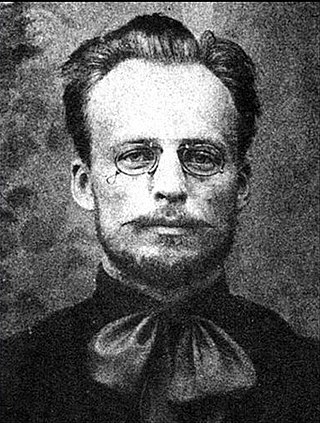
Alexander Konstantinovich Bogomazov or Oleksandr Kostiantynovych Bohomazov was a Ukrainian painter, cubo-futurist, modern art theoretician and is recognised as one of the key figures of the Ukrainian avant-garde scene. In 1914, Oleksandr wrote his treatise The Art of Painting and the Elements. In it he analyzed the interaction between Object, Artist, Picture, and Spectator and sets the theoretical foundation of modern art. During his artistic life Oleksandr Bohomazov mastered several art styles. The most known are Cubo-Futurism (1913–1917) and Spectralism (1920–1930).

Unique Forms of Continuity in Space is a 1913 bronze Futurist sculpture by Umberto Boccioni. It is seen as an expression of movement and fluidity. The sculpture is depicted on the obverse of the Italian-issue 20 cent euro coin.

Cubist sculpture developed in parallel with Cubist painting, beginning in Paris around 1909 with its proto-Cubist phase, and evolving through the early 1920s. Just as Cubist painting, Cubist sculpture is rooted in Paul Cézanne's reduction of painted objects into component planes and geometric solids; cubes, spheres, cylinders, and cones. Presenting fragments and facets of objects that could be visually interpreted in different ways had the effect of 'revealing the structure' of the object. Cubist sculpture essentially is the dynamic rendering of three-dimensional objects in the language of non-Euclidean geometry by shifting viewpoints of volume or mass in terms of spherical, flat and hyperbolic surfaces.

The Street Enters the House is a 1912 oil-on-canvas painting by Italian artist Umberto Boccioni. Painted in the Futurist style, the work centres on a woman on a balcony in front of a busy street, with the sounds of the activity below portrayed as a riot of shapes and colours.
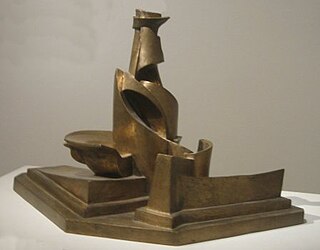
Development of a Bottle in Space is a bronze futurist sculpture by Umberto Boccioni. Initially a sketch in Boccioni’s "Technical Manifesto of Futurist Sculpture"," the design was later cast into bronze by Boccioni himself in the year 1913. Consistent with many of themes in Boccioni’s manifesto, the work of art highlights the artist’s first successful attempt at creating a sculpture that both molds and encloses space within itself.

Girl Running on a Balcony is a 1912 painting by Giacomo Balla, one of the forerunners of the Italian movement called Futurism. The piece indicates the artist's growing interests in creative nuances which would later formally be realized as part of the Futurist movement. The artist was heavily influenced by northern Italians' use of Divisionism and the French's better-known pointillism. Created with oil on canvas just on the brink of World War I, the Futurist movement is embodied by a dark optimism for a future of speed, turbulence, chaos, and new beginnings. Most of Giacaomo Balla's pieces allude to the wonder of dynamic movement, and this painting is no exception. The oil painting is now in the Museo del Novecento, in Milan.
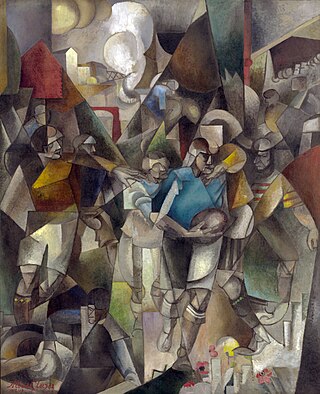
Football Players is a 1912–13 painting by the French artist Albert Gleizes. The work was exhibited at the Salon des Indépendants, Paris, March–May 1913. September through December 1913 the painting was exhibited at Erster Deutscher Herbstsalon, Berlin. The work was featured at Galeries Dalmau in Barcelona, 29 November – 12 December 1916, Gleizes' first one-person show. The work was again exhibited at Galeries Dalmau 16 October – 6 November 1926. Stylistically Gleizes' Football Players exemplifies the principle of mobile perspective laid out in Du "Cubisme", written by himself and French painter Jean Metzinger. Guillaume Apollinaire wrote about Les Joueurs de football in an article titled "Le Salon des indépendants", published in L'Intransigeant, 18 March 1913, and again in "A travers le Salon des indépendants", published in Montjoie!, Numéro Spécial, 18 March 1913.

Dynamism of a Cyclist is a 1913 oil painting by Italian Futurist artist Umberto Boccioni (1882–1916) that demonstrates the Futurist fascination with speed, modern methods of transport, and the depiction of the dynamic sensation of movement.

Isabel Quintanilla was a Spanish visual artist belonging to the new Spanish realism movement. Her paintings usually portray still life, describing simple objects and views from everyday life, as well as landscape paintings.

Annunciation is a 1575–1576 oil painting on canvas by the Greek artist of the Spanish Renaissance El Greco. It is one of the earliest paintings by the artist and depicts the Annunciation, a key topic in Christian art. The painting is now in the Thyssen-Bornemisza Museum, in Madrid.

Dynamism of a Soccer Player is a 1913 Futurist oil painting by Italian artist Umberto Boccioni (1882–1916). It is held in the Museum of Modern Art in New York.

Vision of Spain, and also known as The Provinces of Spain, is a 1913–19 series of fourteen monumental canvases by Spanish painter Joaquín Sorolla depicting the customs, costumes, and traditions of regions of Spain. The series was commissioned by Archie Huntington for the Hispanic Society of America (HSA).

Landscape with Venus and Adonis is an oil-on-canvas painting by Flemish painter Tobias Verhaecht. The work was probably painted in the 1600s, and is now in the Thyssen-Bornemisza Museum in Madrid.

Cyclist is a 1913 Cubo-Futurist painting by the Russian artist Natalia Goncharova. The painting is considered an "archetypal work" of Futurism by its current holder, the State Russian Museum.




















